» posted on Sunday, March 3rd, 2013 by Linda Lou Burton
Sunday in the Park with George
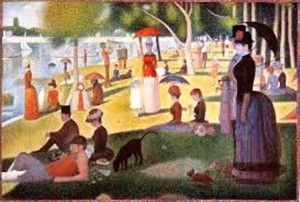 Linda Burton posting from Raleigh, North Carolina – Stephen Sondheim (b 1930) is an accomplished American composer best known for his contributions to musical theater. In 1984 he and James Lapine put together a Broadway production called Sunday in the Park with George. It opened to mixed reviews, but in the end, wound up winning a Pulitzer Prize for drama, two Tony Awards for design, the 1991 Olivier Award for Best Musical, and the 2007 Olivier Award for Outstanding Musical Production. The play was inspired by a painting called A Sunday Afternoon on the Island of La Grande Jatte, done by George Seurat (1859-1891), a French Post-Impressionist painter. It took George two years to complete this 10-foot-wide piece that shows members of different social classes participating in various
Linda Burton posting from Raleigh, North Carolina – Stephen Sondheim (b 1930) is an accomplished American composer best known for his contributions to musical theater. In 1984 he and James Lapine put together a Broadway production called Sunday in the Park with George. It opened to mixed reviews, but in the end, wound up winning a Pulitzer Prize for drama, two Tony Awards for design, the 1991 Olivier Award for Best Musical, and the 2007 Olivier Award for Outstanding Musical Production. The play was inspired by a painting called A Sunday Afternoon on the Island of La Grande Jatte, done by George Seurat (1859-1891), a French Post-Impressionist painter. It took George two years to complete this 10-foot-wide piece that shows members of different social classes participating in various 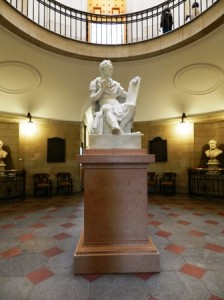 park activities on a Sunday afternoon; he devised an innovative technique for it called “pointillism,” using tiny juxtaposed dots of color, rather than physically blending the colors on canvas. Very different in its day, and as you might guess, the painting “opened to mixed reviews;” today however it is recognized as a work that altered the direction of modern art. So what does this have to do with Raleigh, North Carolina? I’m about to tell you the story of Antonio Canova (1757-1822), an Italian sculptor, and the controversial statue he did of George Washington (1732-1799) that sits in the rotunda of the North Carolina capitol today. It wasn’t meant to be controversial, of course, and what you see today isn’t what Canova did in 1820; but, well, I’d better start from the beginning to explain.
park activities on a Sunday afternoon; he devised an innovative technique for it called “pointillism,” using tiny juxtaposed dots of color, rather than physically blending the colors on canvas. Very different in its day, and as you might guess, the painting “opened to mixed reviews;” today however it is recognized as a work that altered the direction of modern art. So what does this have to do with Raleigh, North Carolina? I’m about to tell you the story of Antonio Canova (1757-1822), an Italian sculptor, and the controversial statue he did of George Washington (1732-1799) that sits in the rotunda of the North Carolina capitol today. It wasn’t meant to be controversial, of course, and what you see today isn’t what Canova did in 1820; but, well, I’d better start from the beginning to explain.
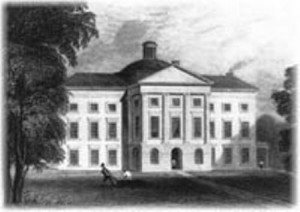 After the War of 1812, the North Carolina General Assembly passed a bill calling for the purchase of a statue of George Washington, setting no limit on the cost. The 1794 State House was considered by many to be very plain; this was meant to lend dignity to the building as well as honoring the Founding Father. Prominent citizens asked the opinion of Thomas Jefferson and he advised them to have the sculpture done by the dominant neoclassical sculptor, Italian artist Antonio Canova.
After the War of 1812, the North Carolina General Assembly passed a bill calling for the purchase of a statue of George Washington, setting no limit on the cost. The 1794 State House was considered by many to be very plain; this was meant to lend dignity to the building as well as honoring the Founding Father. Prominent citizens asked the opinion of Thomas Jefferson and he advised them to have the sculpture done by the dominant neoclassical sculptor, Italian artist Antonio Canova.
Antonio Canova was from the Republic of Venice and was the rave in Europe at the time. His  work was detailed in expression and strikingly elegant; he was famous for marble sculptures that delicately rendered nude flesh, marking a return to classical refinement after Baroque excesses. Since Canova had never seen Washington, he was sent a plaster bust and a drawing of a portrait of Washington in order to aid him in sculpting. Canova never received the drawing, so Washington’s body was left to his imagination. He looked to ancient classical civilizations for inspiration and wound up depicting Washington as a Roman general, dressed in a tunic, body armor, and a short cape. The work was finished nine years later and transported via warship, steamship, and finally mule train to Raleigh before being dedicated on Christmas Eve, 1821.
work was detailed in expression and strikingly elegant; he was famous for marble sculptures that delicately rendered nude flesh, marking a return to classical refinement after Baroque excesses. Since Canova had never seen Washington, he was sent a plaster bust and a drawing of a portrait of Washington in order to aid him in sculpting. Canova never received the drawing, so Washington’s body was left to his imagination. He looked to ancient classical civilizations for inspiration and wound up depicting Washington as a Roman general, dressed in a tunic, body armor, and a short cape. The work was finished nine years later and transported via warship, steamship, and finally mule train to Raleigh before being dedicated on Christmas Eve, 1821.
Mixed reviews? I found these comments written about the statue:
There were those who sharply criticized the sculptor for Romanizing the American general, declaring it to be a better statue of Julius Caesar than of George Washington; nor have such  critics yet been silenced. Nevertheless these criticisms add to rather than detract from the general interest which the statue excites; nor do they lessen the power of the State of North Carolina to restore to the American people what in many respects is the most interesting, if not the most perfect, tribute that art has ever paid to the memory of Washington.
critics yet been silenced. Nevertheless these criticisms add to rather than detract from the general interest which the statue excites; nor do they lessen the power of the State of North Carolina to restore to the American people what in many respects is the most interesting, if not the most perfect, tribute that art has ever paid to the memory of Washington.
The statue of Washington, by the great sculptor Canova, has a lifelike majestic appearance which is indescribable and which would require a personal inspection to appreciate…The statue is of finest Carrara marble, draped as a Roman general in a sitting position. In the left hand is a tablet and in the right a pen and Washington is represented as penning his Farewell Address. The people of North Carolina are prouder of this statue than anything else they possess.
John Ward, a Tour Guide in the capitol, told me that people were surprised when they opened up the crate; George Washington in a tunic, legs exposed? It wasn’t what was expected, but there it was, a $10,000 piece of art, shaped by the hands of a world-famous artist. With much fanfare it was installed in the rotunda; there were those who thought that such a treasure should be put on wheels, so it could be moved quickly if the building ever caught on fire.
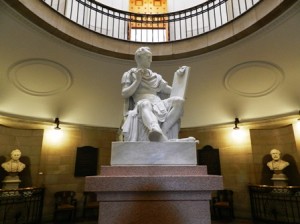 Did they say “I told you so” in 1831, when the State House burned and the statue was destroyed? A new State House was built on the same site as the original; it was completed in 1840 and is where I stood today, looking at a statue of George Washington in the rotunda, dressed in a tunic and sandals, legs exposed. “If it was burned then what is this?” I asked. Turns out, the plaster model Canova used as a guide to create the statue had not been lost or destroyed; it was presented to the state of North Carolina in 1910 by the King of Italy, Victor Emmanuel III. In 1970 another Italian artist, Romano Vio (1913-1984), recreated the marble statue of George Washington using that plaster model as guide, just as Canova had done so many years ago.
Did they say “I told you so” in 1831, when the State House burned and the statue was destroyed? A new State House was built on the same site as the original; it was completed in 1840 and is where I stood today, looking at a statue of George Washington in the rotunda, dressed in a tunic and sandals, legs exposed. “If it was burned then what is this?” I asked. Turns out, the plaster model Canova used as a guide to create the statue had not been lost or destroyed; it was presented to the state of North Carolina in 1910 by the King of Italy, Victor Emmanuel III. In 1970 another Italian artist, Romano Vio (1913-1984), recreated the marble statue of George Washington using that plaster model as guide, just as Canova had done so many years ago.
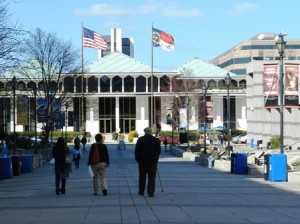 The second marble statue is now safely ensconced in the capitol rotunda; the plaster model is across the street in the North Carolina Museum of History. I saw them both as I visited the park-like complex of buildings that includes the Capitol, the Legislative Building, the Museum of Natural History and the Museum of History; the connecting plaza and the buildings were filled with strolling crowds, out on a Sunday afternoon.
The second marble statue is now safely ensconced in the capitol rotunda; the plaster model is across the street in the North Carolina Museum of History. I saw them both as I visited the park-like complex of buildings that includes the Capitol, the Legislative Building, the Museum of Natural History and the Museum of History; the connecting plaza and the buildings were filled with strolling crowds, out on a Sunday afternoon.
“I just had a Sunday in the park with George,” I thought with a smile as I headed back to my room; that’s when I was reminded of Sondheim’s play, and George Seurat, and controversy, and new and different ways of seeing things, and doing things. Like building a country out of colonies.
